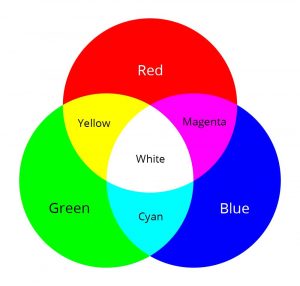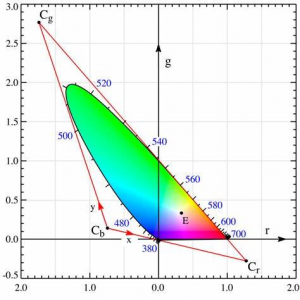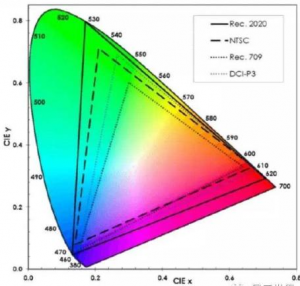In the information society, display products, as the main interface between people and facilitating the exchange of information, have a significant impact on people’s lives. Given the rapid increase of information—in particular, the replacement of traditional single text video information by multimedia digital audio —higher demand for display quality and resolution is proposed for the display device. The colour gamut as a critical factor that affects colour expression and colour reproduction has become the focus of the display. Consequently, different colour gamut standards and the relationship between the colour gamut and colour reproduction of the display will be analyzed based on the principles of colourimetry in this article.
1. Principles of colourimetry
In a colourful world, humans can perceive different colours due to the visual response generated after human eyes receive light signals of different wavelengths. There are two types of photoreceptor cells, rod cells and cone cells, on the retina of the human eyes. Rod cells have no colour recognition function and mainly function in dark light conditions; while cone cells function in bright conditions. Cone cells can be further divided into red-sensitive cone cells, green-sensitive cone cells, and blue-sensitive cone cells, which are most sensitive to red, green, and blue, respectively. The visual responses of these three cones on the retina to red, green and blue light can be combined to form different colour perceptions according to the principle of colour mixing, and thus almost all colours in nature can also be synthesized from red, green and blue. Based on the above principles, red, green, and blue are usually used as the three primary colours in modern display technology, and most colours in nature can be reproduced by mixing the three primary colours at different ratios, as shown in FIG 1. The colour mixing principle can be quantitatively described using a colour equation. For colour light C that needs to be displayed, the colour equation may be expressed as C[C] = R[R] + G[G] + B[B], where C, R, G, and B represent the relative intensities of matched colour light, red light, green light, and blue light, respectively. This colour equation indicates that R units of red primary colour, G units of green primary colour, and B units of blue primary colour can be mixed to work out C units of colour C, where R, G, and B are called tristimulus values.
 red yellow green white
red yellow green white
purple (bright purple)
cyan (greenish-blue, aqua blue)
blue (purplish-blue, ultramarine)
FIG. 1 Mixing principles of three primary colours
2. CIE1931 standard chromaticity system
For comparison and unification, in 1931, the International Commission on Illumination (CIE) proposed a Standard Observer and Coordinate System, using 700nm, 546.1nm, 435.8nm as the wavelengths of the three primary colors of R, G, and B, and normalized the color equation into [C] = R/(R + G + B)[R] + G/(R + G + B) [G] + B/(R + G + B) [B]. The chromaticity coordinates r, g, b are defined, where r = R/(R + G + B), g = G/(R + G + B), and b = B/(R + G + B), and then the color equation can be expressed as [C] = r[R] + g[G] + b[B]. Since r + b + g = 1, the matched color C can be quantitatively characterized by any two of the tristimulus values. Consequently, the CIE 1931 RGB chromaticity diagram characterizes colors quantitatively by using the (r, g) two-dimensional coordinates, as shown in FIG. 2.
 FIG. 2 CIE 1931 RGB chromaticity diagram
FIG. 2 CIE 1931 RGB chromaticity diagram
Due to the problem of the colour matching experiment, negative values exist in the CIE RGB chromaticity diagram, which is not conducive to calculation and understanding. Therefore, the CIE further proposed the CIE 1931 XYZ chromaticity system in which the three primary colours of the RGB system are replaced with three imaginary primary colours XYZ and the tristimulus values R, G, and B are mathematically transformed to tristimulus values X, Y, Z, which are all positive. Correspondingly, the color equation is expressed as C[C] = X[X] + Y[Y] + Z[Z], which can be normalized into [C] = X/(X + Y + Z)[X] + Y/(X + Y + Z)[Y] + Z/(X + Y + Z)[Z]. The normalized equation can be further expressed as [C] = x[X] + y[Y] + z[Z], in which x=X/(X + Y + Z), y=Y/(X + Y + Z), and z=Z/(X + Y + Z). Since x + y + z = 1, the matched colour can be determined by the use of just x and y. Taking x and y as the horizontal and vertical coordinates in a two-dimensional plane, the CIE 1931 XYZ chromaticity diagram as shown in Figure 3 is obtained and colours can be determined by the coordinate of (x,y). In the CIE 1931 XYZ chromaticity diagram, a horseshoe-shaped curve can be obtained by connecting the visible light spectrum from 380 nm to 780 nm. The numbers annotated next to the horseshoe-shaped curve are the spectral wavelength values. The colours located on the horseshoe curve is monochromatic light and has the maximum saturation. While the saturation gradually decreases with the location of the colour go away from the edge to the interior of the horseshoe-shaped area,
3. Color gamut of a display screen and colour gamut standards
Colour gamut can be understood as the range of colours that a display device can display. For the three-primary-colour display most commonly used in modern display technology, based on the principles of colour mixing, the colour coordinates of the three primary colours of red, green, and blue used by the display can be positioned and then connected to obtain a colour gamut triangle in the CIE 1931 XYZ chromaticity diagram. The three vertices of the colour gamut triangle are the coordinates of the red, green, and blue primary colours of the display device. While the area enclosed by the triangle covers all the colours that the display device can display by mixing the three primary colours. The larger the area of the triangle, the wider the colour gamut of the display, and thus the richer the colours that can be displayed.
To facilitate information transmission, a series of colour gamut standards are formulated in the display industry, and the most common standards are NTSC, Rec.709, DCI-P3, and Rec.2020, as shown in FIG. 3.
 FIG. 3 Typical color gamut standards
FIG. 3 Typical color gamut standards
The NTSC colour gamut is a standard released by the National Television Standards Committee of the United States in 1953. This standard was customized for the CRT colour TV at that time. It is too old to be applicable for modern display devices. Moreover, fewer modern display content creators use the NTSC colour gamut, which means that the display products using NTSC as the colour gamut cannot match the display content.
Rec.709 colour gamut standard is the most widely used standard currently, which is released by the International Telecommunication Union in 1990 for high-definition television (HDTV). With the development of computer technology, sRGB colour standard is developed in 1996 by Microsoft together with HP, Mitsubishi, Epson, and other manufacturers. Anchored to the mass of Microsoft’s users, the sRGB standard is supported by most digital image acquisition devices such as digital cameras, digital video cameras, scanners, and monitors. The supports of both display and image acquisition devices make sRGB standard the most widely used colour gamut standard. And thus, Rec.709 colour gamut, which is exactly the same as the sRGB colour gamut, becomes the most prevalent colour gamut currently.
DCI-P3 colour gamut is a wide colour gamut standard introduced by the American film industry in 2005 and is the most commonly used colour standard for digital film devices currently. Compared with the Rec.709 colour gamut, the DCI-P3 colour gamut is wider in the green and red regions, resulting in a 25% larger colour gamut, as shown in FIG. 3. DCI-P3 standard become more and more prevalent with the advent of the 4K devices, as the Rec.709/sRGB is not enough to meet the display requirements.
Rec. 2020 is a colour gamut standard that was introduced by the International Telecommunication Union in 2012 for ultra-high-definition (4K and 8K) devices. As shown in FIG. 3, Rec. 2020 colour gamut covers the widest range among all colour gamut standards currently.
As shown in FIG. 3, among the above colour gamut standards, the Rec.709 colour gamut has the smallest area, the DCI-P3 colour gamut can completely cover the Rec.709 colour gamut, and the Rec.2020 colour gamut can completely cover the DCI-P3 colour gamut. Although the Rec.709 colour gamut area is only 72% of the NTSC colour gamut area, it can not be completely covered by NTSC colour gamut in the blue area. In fact, the NTSC colour gamut can only cover 82% of the Rec.709 colour gamut.
When the colour gamut of a display device can completely cover the colour gamut of the picture to be displayed, the display can fully present the colours in the picture, and restore the creative intention of the video or picture creator. As the creators use Rec.709, DCI-P3, or Rec. 2020 instead of NTSC as the colour gamut to create videos or pictures, display devices use NTSC as the colour gamut can not be connected with the videos or pictures directly. Since the NTSC colour gamut standard cannot completely cover any of the three colour gamut standards of Rec.709, DCI-P3 and Rec.2020, using NTSC colour gamut as the specification of display devices can not indicate the colour gamut coverage of the videos or pictures characterized by Rec.709, DCI-P3, or Rec. 2020. In other words, the NTSC gamut index of the display device is less valuable for consumers, since it can not show the colour reproduction ability of the pictures or videos source data using Rec.709, DCI-P3, or Rec. 2020 gamut index.
4. Summary
Based on the principle of chromaticity, this paper expounds on different chromaticity standards and analyzes the relationship between the colour gamut index and the colour reproduction ability of the display device. As analyzed above, using NTSC colour gamut as the index for LED displays can not characterize the colour reproduction ability. While using the Rec.709, DCI-P3, or Rec.2020 colour gamut as the colour gamut index is a scientific way to characterize the colour reproduction ability of LED displays.




















